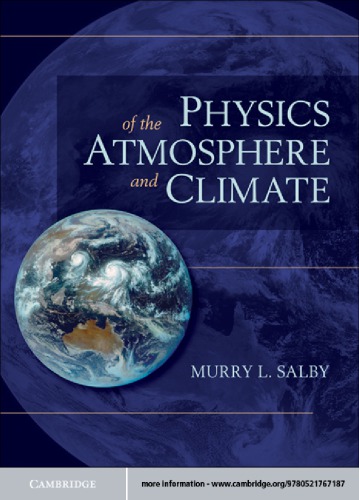

Most ebook files are in PDF format, so you can easily read them using various software such as Foxit Reader or directly on the Google Chrome browser.
Some ebook files are released by publishers in other formats such as .awz, .mobi, .epub, .fb2, etc. You may need to install specific software to read these formats on mobile/PC, such as Calibre.
Please read the tutorial at this link. https://ebooknice.com/page/post?id=faq
We offer FREE conversion to the popular formats you request; however, this may take some time. Therefore, right after payment, please email us, and we will try to provide the service as quickly as possible.
For some exceptional file formats or broken links (if any), please refrain from opening any disputes. Instead, email us first, and we will try to assist within a maximum of 6 hours.
EbookNice Team

Status:
Available5.0
30 reviews
ISBN 10: 0521767180
ISBN 13: 9780521767187
Author: Murry L Salby
1. The Earth-atmosphere system
1.1 Introduction
1.1.1 Descriptions of atmospheric behavior
1.1.2 Mechanisms influencing atmospheric behavior
1.2 Composition and structure
1.2.1 Description of air
1.2.2 Stratification of mass
1.2.3 Thermal and dynamical structure
1.2.4 Trace constituents
1.2.5 Cloud
1.3 Radiative equilibrium of the Earth
1.4 The global energy budget
1.4.1 Global-mean energy balance
1.4.2 Horizontal distribution of radiative transfer
1.5 The general circulation
1.6 Historical perspective: Global-mean temperature
1.6.1 The instrumental record
1.6.2 Proxy records
Suggested references
Problems
2. Thermodynamics of gases
2.1 Thermodynamic concepts
2.1.1 Thermodynamic properties
2.1.2 Expansion work
2.1.3 Heat transfer
2.1.4 State variables and thermodynamic processes
2.2 The First Law
2.2.1 Internal energy
2.2.2 Diabatic changes of state
2.3 Heat capacity
2.4 Adiabatic processes
2.4.1 Potential temperature
2.4.2 Thermodynamic behavior accompanying vertical motion
2.5 Diabatic processes
2.5.1 Polytropic processes
Suggested references
Problems
3. The Second Law and its implications
3.1 Natural and reversible processes
3.1.1 The Carnot cycle
3.2 Entropy and the Second Law
3.3 Restricted forms of the Second Law
3.4 The fundamental relations
3.4.1 The Maxwell Relations
3.4.2 Noncompensated heat transfer
3.5 Conditions for thermodynamic equilibrium
3.6 Relationship of entropy to potential temperature
3.6.1 Implications for vertical motion
Suggested references
Problems
4. Heterogeneous systems
4.1 Description of a heterogeneous system
4.2 Chemical equilibrium
4.3 Fundamental relations for a multi-component system
4.4 Thermodynamic degrees of freedom
4.5 Thermodynamic characteristics of water
4.6 Equilibrium phase transformations
4.6.1 Latent heat
4.6.2 Clausius-Clapeyron Equation
Suggested references
Problems
5. Transformations of moist air
5.1 Description of moist air
5.1.1 Properties of the gas phase
5.1.2 Saturation properties
5.2 Implications for the distribution of water vapor
5.3 State variables of the two-component system
5.3.1 Unsaturated behavior
5.3.2 Saturated behavior
5.4 Thermodynamic behavior accompanying vertical motion
5.4.1 Condensation and the release of latent heat
5.4.2 The pseudo-adiabatic process
5.4.3 The Saturated Adiabatic Lapse Rate
5.5 The pseudo-adiabatic chart
Suggested references
Problems
6. Hydrostatic equilibrium
6.1 Effective gravity
6.2 Geopotential coordinates
6.3 Hydrostatic balance
6.3.1 Hypsometric equation
6.3.2 Meteorological Analyses
6.4 Stratification
6.4.1 Idealized stratification
6.5 Lagrangian interpretation of stratification
6.5.1 Adiabatic stratification: A paradigm of the troposphere
6.5.2 Diabatic stratification: A paradigm of the stratosphere
Suggested references
Problems
7. Static stability
7.1 Reaction to vertical displacement
7.2 Stability categories
7.2.1 Stability in terms of temperature
7.2.2 Stability in terms of potential temperature
7.2.3 Moisture dependence
7.3 Implications for vertical motion
7.4 Finite displacements
7.4.1 Conditional instability
7.4.2 Entrainment
7.4.3 Potential instability
7.4.4 Modification of stability under unsaturated conditions
7.5 Stabilizing and destabilizing influences
7.6 Turbulent dispersion
7.6.1 Convective mixing
7.6.2 Inversions
7.6.3 Life cycle of the nocturnal inversion
7.7 Relationship to observed thermal structure
Suggested references
Problems
8. Radiative transfer
8.1 Shortwave and longwave radiation
8.1.1 Spectra of observed SW and LW radiation
8.2 Description of radiative transfer
8.2.1 Radiometric quantities
8.2.2 Absorption
8.2.3 Emission
8.2.4 Scattering
8.2.5 The Equation of Radiative Transfer
8.3 Absorption characteristics of gases
8.3.1 Interaction between radiation and molecules
8.3.2 Line broadening
8.4 Radiative transfer in a plane parallel atmosphere
8.4.1 Transmission function
8.4.2 Two-stream approximation
8.5 Thermal equilibrium
8.5.1 Radiative equilibrium in a gray atmosphere
8.5.2 Radiative-convective equilibrium
8.5.3 Radiative heating
8.6 Thermal relaxation
8.7 The greenhouse effect
8.7.1 Feedback in the climate system
8.7.2 Unchecked feedback
8.7.3 Simulation of climate
Suggested references
Problems
9. Aerosol and cloud
9.1 Morphology of atmospheric aerosol
9.1.1 Continental aerosol
9.1.2 Marine aerosol
9.1.3 Stratospheric aerosol
9.2 Microphysics of cloud
9.2.1 Droplet growth by condensation
9.2.2 Droplet growth by collision
9.2.3 Growth of ice particles
9.3 Macroscopic characteristics of cloud
9.3.1 Formation and classification of cloud
9.3.2 Microphysical properties of cloud
9.3.3 Cloud dissipation
9.3.4 Cumulus detrainment: Influence on the environment
9.4 Radiative transfer in aerosol and cloud
9.4.1 Scattering by molecules and particles
9.4.2 Radiative transfer in a cloudy atmosphere
9.5 Roles of cloud and aerosol in climate
9.5.1 Involvement in the global energy budget
9.5.2 Involvement in chemical processes
Suggested references
Problems
10. Atmospheric motion
10.1 Description of atmospheric motion
10.2 Kinematics of fluid motion
10.3 The material derivative
10.4 Reynolds’ transport theorem
10.5 Conservation of mass
10.6 The momentum budget
10.6.1 Cauchy’s Equations of Motion
10.6.2 Momentum equations in a rotating reference frame
10.7 The first law of thermodynamics
Suggested references
physics of the atmosphere and climate pdf
physics of the atmosphere and climate salby
how does the atmosphere affect weather and climate
what is atmosphere in physics
how does the atmosphere affect climate
Tags: Murry L Salby, Physics, Climate, Atmosphere